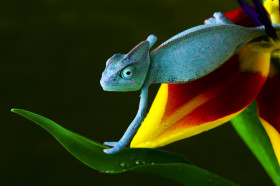
Chameleons are reptiles found predominantly in Madagascar, and some parts of Africa, Europe and Asia. There are over 150 species, in varying sizes and inhabiting rainforests, deserts, etc. While some reside close to the ground, many of them live in trees. And that would explain their grouped toes for climbing and prehensile tails curled around branches for balance. But what sets chameleons apart from most creatures is their colour-changing ability.
Myriad colours, but…
Yes, chameleons do change colour and this may help in camouflage. But most of them already have skin colour that help them blend well with their surroundings. For instance, it is said that tree-dwelling chameleons are in shades of green while their cousins in deserts are more in shades of brown. So it’s a misconception that they can match the colours of their background. Reports say these reptiles predominately change colour for defence, to communicate. Attract mates, display anger, fear, threat, etc., and as a response to changes such as light or humidity in their surroundings.
Here’s how it’s done. The chameleon skin has a few layers. The outermost is said to be transparent. The layer beneath this has special iridescent cells with different colour pigments that also reflect light. The reptile has the ability to change the arrangement of these cells – “by relaxing or exciting the skin”.
All-seeing eyes and long tongues
In addition to a colour-changing skin, they have another rare ability – eyes that move independently of each other, giving these reptiles the chance to look in two different directions simultaneously. When they want to look at something specific, both eyes focus on that object together. Not just that, their cone-shaped eyes rotate, giving them a 360-degree view of their surroundings. Another interesting aspect of the chameleon is its tongue. The sticky tongue is said to be almost twice the length of its body. When it spots its prey, the tongue shoots out with incredible speed, acts as a suction cup and pulls the prey in before the unsuspecting victim has any time to react!
Picture Credit : Google
